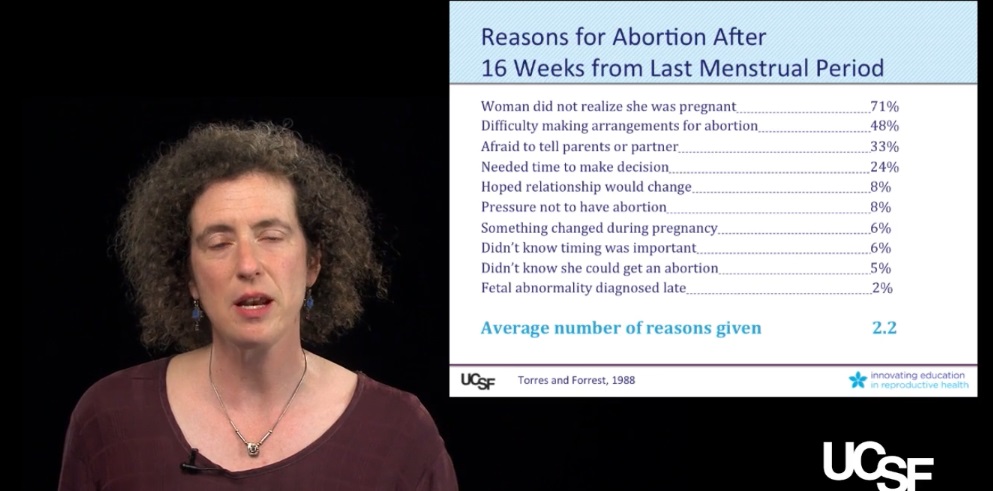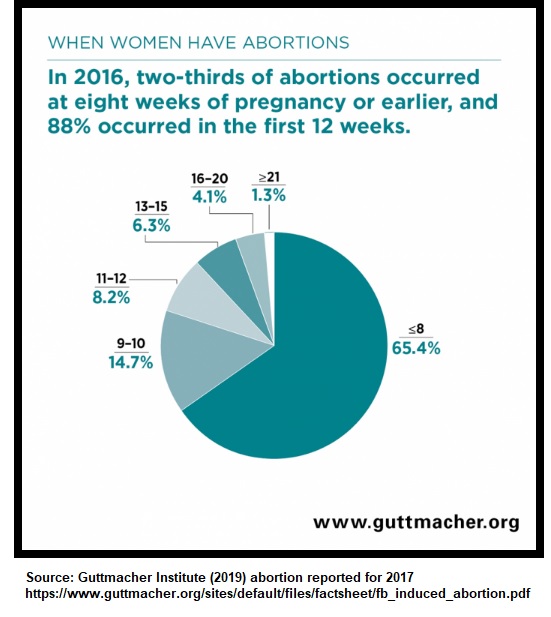Over 100,000 unique human beings are killed in second and third trimester abortions each year — nearly 274 babies each day and at least 11 every hour. Are these babies who, as the media sometimes claims, are too sick to survive? Are these abortions done for dire reasons? The answer to both questions is no.
Do women really get late-term abortions for the most dire of reasons?
The media leads the public to believe that late-term (sometimes referred to as “later” or “late”) abortions only happen in cases of fetal anomalies or because of a health reason (as opposed to an early delivery). But even the abortion industry admits that late-term abortions are often committed on perfectly healthy babies and moms, despite the persistent myth that women only seek late-term abortions in dire circumstances.
Dr. Eleanor Drey, the medical director of the Women’s Options Center of San Francisco General Hospital, which commits abortions into the second trimester, admitted in an abortion training module published by Innovating Education, ” […] there was a study that showed women’s reasons for presenting at 16 weeks or beyond after their last menstrual period. And what they saw was that women often didn’t realize that they were pregnant.”
She goes on to list additional reasons, and as you can see below, fetal anomaly is the lowest on the list:

Eleanor Drey on reasons women obtain late second trimester abortion
How many late-term abortions occur annually?
For that answer, we turn to the two reporting agencies on abortion: The Centers for Disease Control and Prevention (CDC) and the Guttmacher Institute, a former “special affiliate” of Planned Parenthood. There is no federal requirement for abortions to be reported and no requirement to report abortions by gestation. In addition, these two reporting agencies vary in their numbers. Live Action News previously explained some of the reasons for the variation:
- The CDC’s overall abortion numbers are generally much lower than numbers released by the Guttmacher Institute. The CDC uses data from states, and since not every state requires abortion reporting — and those that do differ in what information is collected — abortions by trimester (gestation) will vary.
- Guttmacher gathers its figures from surveys, which it claims it sends directly to all known abortion facilities, categorized by type. Despite more comprehensive figures, Guttmacher neglects to break down reported abortion data beyond 21 weeks of pregnancy.
CDC estimates tens of thousands of late-term abortions
In 2019, the CDC recorded a total of 629,898 abortions from 49 states, which voluntarily reported these numbers on April 9, 2021. An estimated 6,300 babies were aborted at or past 21 weeks gestation in just 43 reporting areas, according to the recently released CDC data. In addition, an estimated 39,000 abortions were committed between 14 and 20 weeks gestation. That means that over 45,000 babies were reported to have been aborted at 14 weeks and greater. Babies have survived when born prematurely as early as 21 weeks gestation.
To calculate estimates on abortion by gestation, Live Action News used the CDC’s abortion percentages for the 43 reporting areas against the total abortions reported in 2019 (629,898):
- 0-6 weeks (42.9%) – estimated 270,226
- 7-9 weeks (36.4%) – estimated 229,283
- 10-13 weeks (13.4%) – estimated 84,406
- 14-15 weeks (2.9%) – estimated 18,267
- 16-17 weeks (1.7%) – estimated 10,708
- 18-20 weeks (1.6%) – estimated 10,078
- 21 weeks or greater (1%) – estimated 6299
The data excludes nine reporting areas known for committing later abortions (California, District of Columbia, Illinois, Maryland, Massachusetts, New Hampshire, New York State, Pennsylvania, and Wisconsin) that did not report, did not report by gestational age, or did not meet reporting standards.

The data shows a decrease from what CDC recorded in 2018, when an estimated 49,000 abortions were committed at 14 weeks or later, with nearly 6,200 of those committed at or over 21 weeks — the point at which some premature babies have survived with assistance.
According to the CDC, between 2018 (77.7%) and 2019 (79.3%), the percentage of abortions committed at nine weeks gestation or less slightly increased while abortions at 13 weeks gestation or less remained relatively the same. Abortions 14-20 weeks dropped slightly from 6.9% in 2018 to 6.2% in 2019, while those recorded at 21 weeks or greater remained the same at 1%.
Guttmacher estimates approximately 100,000 late-term abortions by gestation
In 2017, Guttmacher reported a total of 862,320 abortions, claiming that two-thirds of abortions occurred at eight weeks or earlier. Using the same percentages from Guttmacher’s graph below (2016), we discover that over 100,000 (100,891) abortions took place in the second trimester or later with over 11,000 occurring at 21 weeks or greater.
- 8 weeks or less (65.4%) – 563,957 abortions
- 9-10 weeks (14.7%) – 126,761 abortions
- 11-12 weeks (8.2%) – 70,710 abortions
- 13-15 weeks (6.3%) – 54,326 abortions
- 16-20 weeks (4.1%) – 35,355 abortions
- At or greater than 21 weeks (1.3%) – 11,210 abortions

Guttmacher 2016 abortion by trimester (Graph: Guttmacher Institute)
That 100,000 annual late-term abortion statistic is not small. It’s equal to the…
- Approximate number of deaths in the Bosnian Genocide by 1995.
- Deaths following Saddam Hussein’s mustard gas and nerve agents attacks on Iraqi Kurds.
- More deaths than number of reported drug overdose deaths in 2017 in the U.S.
- Twice as many as reported deaths from opioid drugs in 2017.
Abortions at or after 15 weeks
In 2021, the U.S. Supreme Court heard arguments in Dobbs v. Jackson Women’s Health Organization, a Mississippi case to determine whether the state can prohibit “previable” abortions at 15 weeks or later.
Guttmacher estimates that nationally, between 54,000 and 63,000 abortions take place annually at or after 15 weeks, and the vast majority are done by D&E, an abortion method that involves the direct dismemberment of a child in the womb.
“While not every abortion at or after 15 weeks is provided using the D&E method, the vast majority are. Guttmacher estimates that between 6.3% and 7.4% of all U.S. abortions are obtained at or after 15 weeks of pregnancy. Based on 2017 abortion incidence statistics, this means that between 54,000 and 63,000 abortions nationwide occur in this time frame,” Guttmacher wrote.
This brings the daily national death toll for babies killed at or after 15 weeks to between 148 and 173.
Later abortion at or after 21 weeks (1.3%)
Both CDC and Guttmacher acknowledge that abortions committed at 21 weeks or greater represent 1% to 1.3% of all reported abortions — and this is no small number, either.
CDC data reveals:
- 6,299 (estimated) late-term abortions in 2019 (CDC).
- 6,196 (estimated) late-term abortions in 2018 (CDC).
- 7,481 (estimated) late-term abortions in 2016 (CDC).
Using Guttmacher’s 1.3% figure, we estimate that 11,210 babies are aborted at 21 weeks gestation or greater in one year in 2017, a total of nearly 31 babies every single day — more than the average Kindergarten classroom.
While the media downplays the numbers of later abortions as small, data published by the CDC’s National Vital Statistics Reports on deaths of born residents registered in the United States offers comparisons to that allegedly small 1-1.3%. In 2019 that report revealed there were 2,854,838 deaths reported that year. These deaths below, all from 2019, reflect a similar range to the 1.3 percent of the total reported abortion deaths after 21 weeks, when preemies have been known to survive with assistance:
- Motor vehicle traffic related injuries resulted in 37,595 deaths, representing 1.3 percent of all deaths recorded that same year.
- A total of 39,707 persons died from firearm-related injuries in the United States, roughly 1.4 percent of all deaths recorded that same year.
- A total of 39,043 persons died of alcohol-induced causes in the United States, roughly 1.4 percent of all deaths recorded that same year.
Who commits late-term abortions?
According to Guttmacher’s 2017 report, 25% of abortion facilities commit abortions up to 20 weeks, and just 10% up to 24 weeks. There are facilities, however, which commit abortions even later in gestation.
Planned Parenthood commits elective abortions up to the 24th week and opposes late-term abortion restrictions.
A 2021 analysis by the Abortion Care Network (ACN) noted that independent abortion clinics (IACs) comprised 79% of all U.S. facilities that commit abortion at or after 22 weeks, and 100% of all U.S. facilities that commit abortion after 26 weeks of pregnancy.
Who has later abortions?
In 2014, Guttmacher claimed that “women with less education, Black women and [w]omen who had experienced multiple disruptive life events in past year” were more likely than others to have had an abortion at or beyond 13 weeks’ gestation.
According to the CDC, most abortions are committed on women in their 20s. The CDC’s 2019 data also shows that out of 339,997 abortions reported by race/ethnicity and gestation, 93% were committed from 0-13 weeks and 7% were committed at 14 weeks or later. Of those, white women had 31% (7,449), Black women had 42% (10,100), and Hispanic women had 18% (4,378).
According to a January 2022 analysis published by Guttmacher, 44 states prohibit some abortions after a certain point in pregnancy, the group claims, adding that 22 states ban abortion between 13 and 24 weeks, while 20 states impose a ban at viability.
“Like” Live Action News on Facebook for more pro-life news and commentary!







